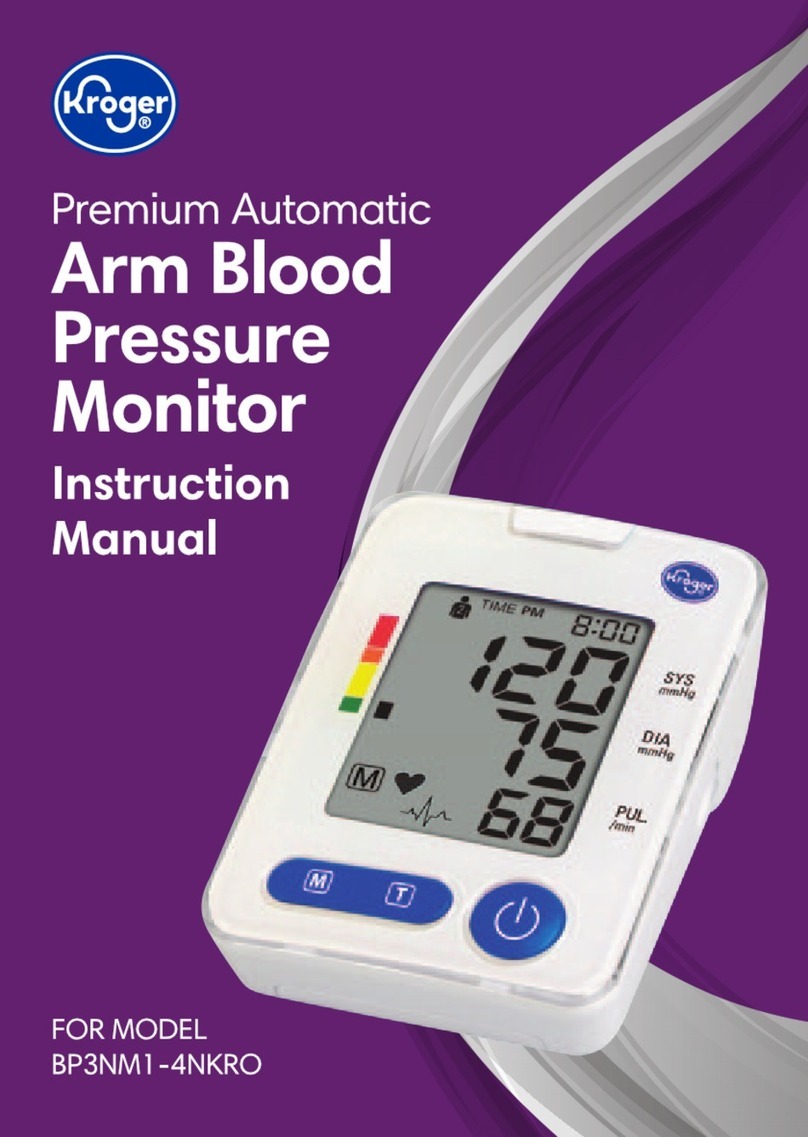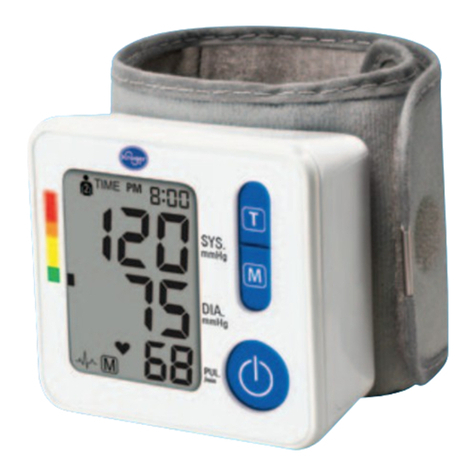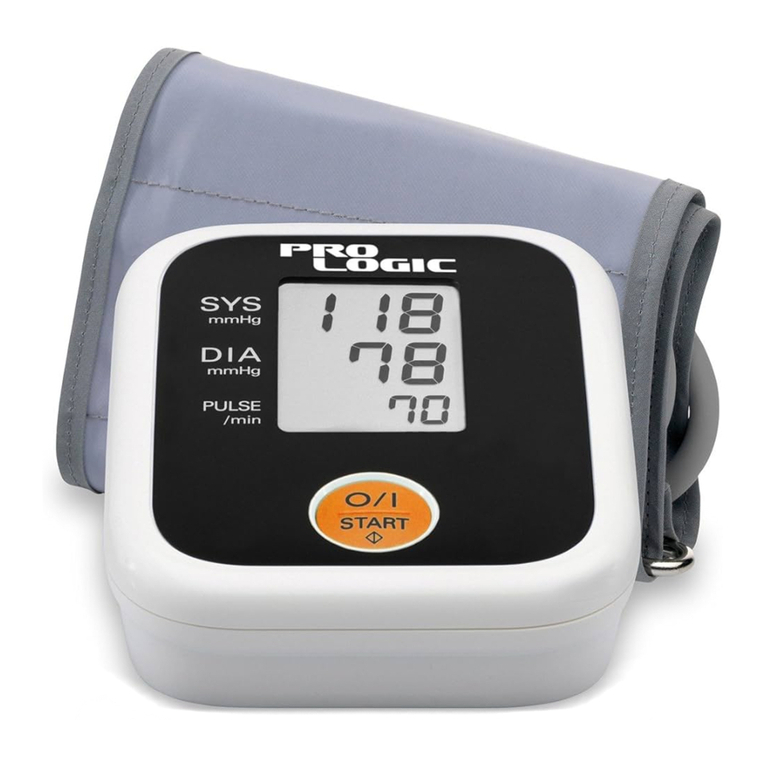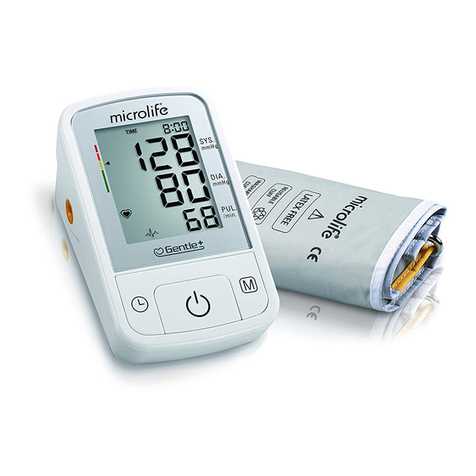Kroger BP3NL1-1AKRO User manual


1
mportant Product and Safety nformation
Follow nstructions for Use. This document provides important
product operation and safety information regarding
this Blood
Pressure Monitor. Please read this document thoroughly before using
the device and keep for future reference.
This blood pressure monitor is an automatic digital blood pressure measuring
device for use by adults on the upper arm at home or in the doctor’s office. It
enables a very fast and reliable measurement of the systolic and diastolic blood
pressure, as well as the pulse rate, by way of the oscillometric method. This
device detects the appearance of irregular heartbeats during measurement and
provides a warning signal when the irregular heartbeat is detected.
This blood pressure monitor S intended to be used:
• For self-measurement/monitoring of blood pressure and pulse in adults; whereas
the person being measured may be the user/operator of the device.
• Within a home healthcare environment.
• With a cuff located upon the user’s upper arm; ½ inch above the elbow over
the artery as indicated on the cuff.
This blood pressure monitor S NOT intended for use with:
• Pregnancy
• Preeclampsia
• hildren under 12
• Neonatal patients
WARN NG – Potentially hazardous situation that if not avoided
may result in serious injury or death.
• Self-measuring means monitoring, not diagnosis or treatment. Unusual
values
must always be discussed with your doctor. Under no circumstances
should you
independently alter the dosages of any drugs prescribed by your physician.
• onsult your physician before using this device if any of the following or simi-
lar conditions are present: arrhythmias such as atrial or ventricular premature
beats or atrial fibrillation, arterial sclerosis, poor perfusion, diabetes, age,
pregnancy, preeclampsia, renal diseases. Motion during
measurement, includ-
ing trembling or shivering may affect the measurement.
• Though not for use with children under 12, ensure that any children around this

device are supervised; some parts are small enough to be swallowed and any
present tubes or cables may provide a risk of strangulation.
• Ensure the cuff tubing is not kinked during use as harmful injury may occur
due to the effect of blood flow interference caused by high pressure in the
cuff not releasing.
DO NOT:
Use this device if you think it is damaged or anything appears unusual (e.g.
sporadic operation, open packaging upon purchase).
Use the displayed pulse for checking the frequency of heart pacemakers as
this device is not suitable for this action.
Open/modify this device; inaccuracy and/or harmful injury may result.
onduct many frequent measurements as this may result in harmful injury due
to blood flow interference.
Place the uff over a wound as this may cause additional injury.
Place and pressurize the uff over/near any present intravascular access or
therapy, or arteriovenous shunt, as this may cause blood flow interference and
result in harmful injury.
Place and pressurize the uff over a limb near the side of a mastectomy as
this may cause harmful injury.
Use the Blood Pressure Monitor on a limb simultaneously with other medical
equipment on the same limb due to possible interference with such medical
equipment.
Maintain pressure in the uff applied to the limb for a prolonged amount of
time. Ensure that circulation in the limb is not impaired by checking circulation
if prolonged/repeated exposure to pressure occurs.
Service the device when being used or when power is supplied. When the
device is not in use and power is removed, cuff assembly, batteries and A
adapter (if applicable) may be replaced by the user with Microlife supplied
replacements. No other parts/components are accessible.
CAUT ON – Potentially hazardous situation that if not avoided may
result in minor/moderate injury, property damage, and/or damage
to the device
• This device contains sensitive electronics components. Avoid strong electrical
2

or electromagnetic fields in the direct vicinity of the device (e.g., mobile tele-
phones, microwave ovens). These can lead to temporary impairment of the
measuring accuracy. Move the device to another location if interference is
determined.
• When not using the Blood Pressure Monitor for extended lengths of time,
remove the batteries to avoid potential battery leakage and damage to the
monitor.
• When replacing the batteries, ensure all the batteries are replaced simultane-
ously to avoid battery damage and potential damage to the
monitor. Microlife
USA does not recommend using rechargeable batteries.
• To avoid inaccurate measurements and to lessen any discomfort from uff
pressure, ensure the uff is placed correctly on the limb and fits correctly
when snug (not tight), as indicated by markings with the uff.
• onsult your physician in cases of frequent irregular heartbeat detections.
• This Risk Indicator feature is provided in order to help you understand your
potential blood pressure risk. However, this feature is neither a diagnosis nor
a substitute for a medical examination. It is important to consult with your
physician to determine your risk.
DO NOT:
Drop this device or expose it to strong vibrations; sensitive components may
be affected resulting in inaccuracies and/or operational issues.
Use the Blood Pressure Monitor outside of its specified operation temperature
and humidity rating, or if stored outside of its specified storage temperature
and humidity rating. Avoid storage in direct sunlight.
Use this device in a moving vehicle; inaccurate measurements may result.
Use third party accessories. Only use Microlife authorized accessories, such as
cuffs or A adapters, as those not approved for use with the device may provide
inaccurate measurements, injury, and/or damage the device.
STANDARDS
In addition to the standards stated in the Instruction Manual:
• This medical device is compliant with medical device and non-invasive blood
pressure monitor standards IE 60601-1, IE 60601-1-2, IE 60601-1-11, and
AAMI/ANSI/IE 80601-2-30, and
3

4
• Electromagnetic standards IE 60601—1-2 along with F Part 15, and
• linical Testing per standard ISO 81060-2:2013 was conducted on blood pres-
sure device using the same measurement technology.
Please note: According to international standards, your monitor should be
checked for accuracy every 2 years.
TYPE
IP20 Protected against solid foreign particles with a diameter of more than 12.5
mm, no protection against water. Keep Dry.
Type BF Applied Part
Batteries and electronic instruments must be disposed of in accordance with the
locally applicable regulations, not with domestic waste.
Expected Life
Monitor: 5 Years
uff: 2 Years
BHS
The B.H.S. (British Hypertension Society) clinical protocol was used to measure the
accuracy of this product. Blood pressure units using the same measurement technolo-
gy are graded “AA” for systolic/diastolic accuracy by independent investigators using
the BHS protocol. This is the highest grading available for blood pressure monitors.
Please see bhsoc.org for more information. (Uses the same algorithm as B.H.S. graded
“AA” model number 3BT0-1)
FCC
This device complies with part 15 of the F Rules. Operation is subject to the
following
two conditions: (1) This device may not cause harmful interference, and
(2) this device must accept any interference received, including interference that
may cause undesired operation. hanges or modifications to the product are not
approved by Microlife USA and could void the user's authority to operate the
equipment under F jurisdiction.

5
This equipment has been verified to comply with the limits for a lass B digital
device, pursuant to part 15 of the F Rules. These limits are designed to provide
reasonable protection against harmful interference in a residential installation.
This equipment generates uses and can radiate radio frequency energy and, if
not used in accordance with the instructions, may cause harmful interference to
radio communications. However, there is no guarantee that interference will not
occur in a particular installation. If this equipment does cause harmful interfer-
ence to radio or television reception, which can be determined by turning the
equipment on and off, the user is encouraged to try to correct the interference by
increasing the distance between the product and the affected device; or if applic-
able, reorientation the receiving antenna, or moving the product’s power plug to
another receptacle.

6
Automatic Blood Pressure Monitor
Instruction Manual
Table of contents
1. ntroduction
1.1. Your automatic blood pressure monitor
2. How is blood pressure measured?
2.1. What is blood pressure, and why does it fluctuate?
2.2. Measurement guidelines
2.3. What can I do to change my blood pressure?
3. Components of your blood pressure monitor
4. How do get started?
4.1. Inserting the batteries
4.2. Tube connection
5. How do take a measurement?
5.1. Preparing to take a measurement
5.2. ommon errors
5.3. Using the cuff
5.4 Taking a measurement
5.5. Irregular heartbeat detection
5.6. Memory: reviewing the last reading
5.7. Stopping a measurement
5.8. Battery change indicator
6. Error messages/troubleshooting
7. Care and maintenance
8. Limited warranty

7
9. Technical specifications
10.How to contact us

1. ntroduction
1.1.Your Automatic Blood Pressure Monitor
Thank you for purchasing a fully automatic blood pressure monitor. Your
monitor is designed to provide fast and reliable digital readings of your
pulse, and systolic / diastolic blood pressure using the oscillometric
method on your upper arm. It offers clinically proven accuracy and has
been designed to be user friendly.
Before using your blood pressure monitor, please read this instruction
manual carefully to ensure correct use. If you have additional questions
regarding blood pressure measurements please contact your doctor.
2. How is blood pressure measured?
2.1. What is blood pressure, and why does it fluctuate?
Your level of blood pressure is determined in the circulatory center of the
brain and adjusts to a variety of situations through feedback from the ner-
vous system. To adjust blood pressure, the strength and frequency of the
heart (Pulse), as well as the width of circulatory blood vessels is altered.
Blood vessel width is effected by fine muscles in the blood vessel walls.
Your level of arterial blood pressure changes periodically during heart
activity: During the “blood ejection” (Systole) the value is highest (sys-
tolic blood pressure value). At the end of the heart’s “rest period”
(Diastole) pressure is lowest (diastolic blood pressure value). Blood
pressure values must lie within certain normal ranges in order to pre-
vent particular diseases.
2.2.Measurement guidelines
Blood pressure is too high if at rest, your systolic blood pressure is over
160 mmHg and/or your diastolic pressure is above 100 mmHg
. In this
case, please consult your doctor immediately. Long-term values at this
level endanger your health due to continual damage to the blood ves-
sels in your body.
8

Should the systolic blood pressure values lie between 140 mmHg and
159 mmHg and/or the diastolic blood pressure values lie between 90 mmHg
and 99 mmHg, consult your doctor. Regular self-checks will be necessary.
With blood pressure values that are too low (i.e. systolic values under
105 mmHg and/or diastolic values under 60 mmHg), consult your doctor.
Even with normal blood pressure values, a regular self-check with your
blood pressure monitor is recommended. You can detect possible
changes in your values early and react appropriately.
If you are undergoing medical treatment to control your blood pressure,
keep a record of values along with time of day and date. Show these
values to your doctor. Never use the results of your measurements to
independently alter the medication prescribed by your doctor.
Which values are normal?
The following standards for assessing high blood pressure in adults
have been established by the American Heart Association (AHA) and
American ollege of ardiology (A ) in 2017.
Additional information
• This chart reflects a 2017 update to blood pressure standards.
• If your values are mostly normal under resting conditions but excep-
tionally high under conditions of physical or psychological stress, it is
possible that you are suffering from so-called “labile hypertension”.
onsult your doctor.
Category Systolic Diastolic
(mm Hg) (mm Hg)
Normal <120 and <80
Elevated 120-129 and <80
Hypertension
Stage 1 Hypertension 130-139 or 80-89
Stage 2 Hypertension 140-179 or 90-119
Hypertensive risis ≥180 or ≥120
9

10
2.3. What can do to change my blood pressure?
a) onsult your doctor.
b) Increased blood pressure values (various forms of hypertension) are
associated with considerable health risks over time. Arterial blood
vessels in your body are endangered due to constriction caused by
deposits in the vessel walls (Arteriosclerosis). A deficient supply of
blood to important organs (heart, brain, muscles) can result from arte-
riosclerosis. Furthermore, the heart will become structurally damaged
with increased blood pressure values.
c) There are many different causes of high blood pressure. We differen-
tiate between the common primary (essential) hypertension, and sec-
ondary hypertension. The latter group can be ascribed to specific
organic malfunctions. Please consult your doctor for information
about the possible origins of your own increased blood pressure values.
d) There are measures which you can take to reduce and prevent high
blood pressure. These measures must be permanent lifestyle
changes.
A) Eating habits
• Strive for a normal weight corresponding to your age. See your doctor
for your ideal weight.
• Avoid excessive consumption of common salt.
• Avoid fatty foods.
B) Previous illnesses
•
onsistently follow all medical instructions for treating illnesses such as:
• Diabetes (Diabetes mellitus or sugar diabetes)
• Fat metabolism disorder
• Gout

11
C) Habits
• Give up smoking completely
• Drink only moderate amounts of alcohol
• Restrict your caffeine consumption (coffee, tea, chocolate)
D) Physical constitution
• After a preliminary medical examination, exercise regularly.
• hoose sports which require stamina and avoid those which require
strength.
• Avoid reaching the limit of your performance.
• With previous illnesses and/or an age of over 40 years, please con-
sult your doctor before beginning your sporting activities He/She will
advise you regarding the type and extent of types of sport that are
possible for you.
D) Your physical condition
• After a medical examination, and with your doctor’s approval
and direction; exercise.
• hoose sports which require stamina and avoid those which require
strength.
• Avoid reaching the limit of your performance.
• With previous illnesses and/or an age of over 40 years, please con-
sult your doctor before beginning your exercise routine. Speak with
your doctor regarding the type and extent of exercise that is appropri-
ate for you.

12
3. Components of your blood pressure monitor
The illustration shows the blood pressure monitor consisting of:
a) Measuring unit
b) Upper arm cuffs:
The cuff is for arm circumference 24–34 cm or
9.5” - 13.25” (included)
Please Note:
Do not force cuff connection into the opening. If
the cuff is too small, or if you need a replace-
ment cuff, call toll free 1-800-568-4147 for
additional information.
uff connection START/STOP
button
L D-display
Heartbeat
Battery Indicator
Memory
Systolic
Diastolic
Pulse Irregular Heartbeat

13
4. How do get started?
4.1. nserting the batteries
After unpacking your device, insert the batteries. The battery compart-
ment is located on the bottom of the device.
a) Remove cover on the bottom of the monitor.
b) Insert the batteries (4 x size AA 1.5 V), following the indicated
polarity. (+ -)
c) If the low battery indicator appears in the display, the batteries are
discharged and the unit will not function.
d) If the batteries are inserted incorrectly, the display may function
erratically or not at all. heck battery polarity.
Attention!
• After the low battery indicator appears, the device
won’t function until the batteries have been replaced.
•
Please use AA Long-Life 1.5 V batteries
and replace
them all at once.
• Do not use rechargeable batteries.
•
If the blood pressure monitor is not used for long peri-
ods,
remove the batteries from the device.
Low Battery Indicator

4.2. Tube connection
Insert the cuff tube into the opening
provided on the left side of the monitor,
as shown in the diagram.
5. How do take a measurement?
Please note: You should always be seated before and during measurement
5.1.Preparing to take a measurement
• Avoid eating and smoking as well as all forms of exertion directly
before measurement. These factors influence the measurement
result. Find time to relax by sitting in an armchair in a quiet atmos-
phere for about 5 minutes before measurement.
• Remove any garment that fits closely to your upper arm.
• Always measure on the same arm (normally left).
• Always perform measurements at the same time of day, since the
blood pressure changes during the course of the day.
14

15
5.2.Common errors:
Note: Comparable blood pressure measurements always require
the same conditions! These are normally quiet conditions.
• All efforts by the user to support the arm can increase blood pres-
sure. Make sure you are in a comfortable, relaxed position and do not
flex any of the muscles in the measurement arm during the measure-
ment. Use a cushion for support if necessary.
• If the arm artery lies considerably lower or higher than the heart, an
erroneously high or low blood pressure will be measured. Each 15 cm
(6”) difference in height between your heart and the cuff results in a
measurement error of 10 mmHg.
• uffs that are too small result in false measurement values.
Selecting the correct cuff is extremely important. uff size is depen-
dent upon the circumference of the arm (measured in the center). The
permissible range is printed on the cuff. If this is not suitable for your
use, please call 1-800-568-4147.
• A loose cuff or a sideways protruding air pocket causes false mea-
surement values.
• With repeated measurements, blood accumulates in the arm, which
can lead to false results. onsecutive blood pressure measurements
should be repeated after a 1 minute pause in order to allow the
accumulated blood to flow away.

½”
9.5” - 13.25”
Artery
5.3. Using the cuff
a) Pass the end of the cuff through the flat metal ring
so that a loop is formed. The hook and loop material
must be facing outward. (Ignore this step if the cuff
has already been prepared.)
b) Slide the cuff over the left upper arm until the bot-
tom edge is about 1/2” above your elbow.
mportant! The Artery Mark must lie over the
artery which runs down the inner side of the arm.
T P: Align white artery mark to pinky finger.
c) Tighten the cuff by pulling the end and close the
cuff by affixing the hook and loop material. Make
sure that the cuff Index end falls between the OK
lines when the cuff is in position. If it doesn’t, you
are using the wrong cuff size.
d) There should be little free space between the arm
and the cuff. You should be able to fit 2 fingers
between your arm and the cuff. lothing must not
restrict the arm. Any piece of clothing which does
must be removed.
e) Lay your arm on a table (palm upward) so the cuff is at
the same height as the heart. Make sure that the tube
is not kinked.
16

17
f) Remain seated quietly for 5 minutes before you
begin the measurement.
Comment:
If it is not possible to fit the cuff to the left arm, it
can also be placed on your right arm. However, all
measurements should be made using the same arm.
uff on right arm

18
5.4.Taking a measurement
After the cuff has been appropriately positioned
the measurement can begin. Remain still during
your measurement, do not flex muscles.
a) Press the START/STOP button. The pump
begins to inflate the cuff. In the display, the
increasing cuff-pressure is continually displayed.
b) After automatically reaching an individual
pressure, the pump stops and the pressure
slowly falls. The cuff-pressure is displayed
during the measurement. If the inflation
pressure is not sufficient, the monitor auto-
matically re-inflates.
c) When the device has detected your pulse,
the heart symbol in the display begins to
blink.
d)
When the measurement has been concluded,
the cuff deflates. The measured systolic and
diastolic blood pressure values as well as
the pulse are now displayed.
e) The measurement results are displayed until
you switch the device off. The device will
turn off automatically after 1 minute if no
buttons are pressed. Measurement
complete
Systolic
Diastolic
Pulse
Pumping
Pressure
Measuring

19
5.5. rregular Heartbeat detection
The appearance of this symbol indicates that certain
pulse irregularities were detected during the measure-
ment. In this case, the result may deviate from your nor-
mal basal blood pressure – repeat the measurement. In
most cases, this is no cause for concern. However, if the
symbol appears on a regular basis (e.g., several times a
week with measurements taken daily), we advise you to
tell your doctor.
Please show your doctor the following explanation:
nformation on frequent appearance of the irregular
heartbeat symbol
This instrument is an oscillometric blood pressure monitor
device that also analyzes pulse frequency during mea-
surement. The instrument is clinically tested.
If pulse irregularities occur during the measurement, the
irregular heartbeat symbol is displayed with the measure-
ment. If the symbol appears frequently or if it suddenly
appears more often than usual, we recommend the
patient seek medical advice.
The instrument does not replace a cardiac examination
but serves to detect pulse irregularities at an early stage.
Table of contents
Languages:
Other Kroger Blood Pressure Monitor manuals
Popular Blood Pressure Monitor manuals by other brands
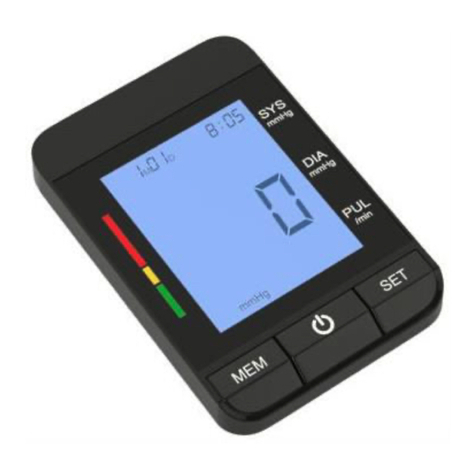
Shenzhen Urion Technology
Shenzhen Urion Technology U80R instruction manual

PYLE HEALTH
PYLE HEALTH PHBPB16TL instruction manual

B.Well
B.Well PRO-36 Instructions for use

Omron
Omron IntelliSense HEM-790ITCAN instruction manual

innohaus
innohaus ABC 30 Instructions for use
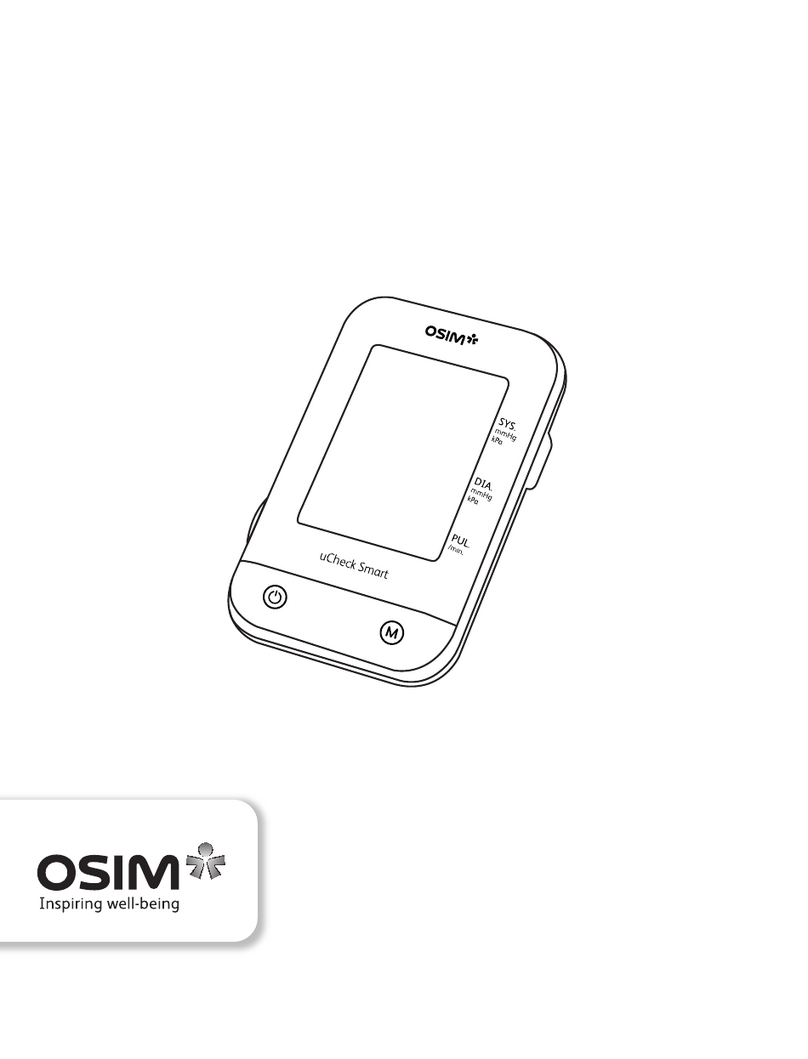
OSIM
OSIM uCheck Smart Operation manual
